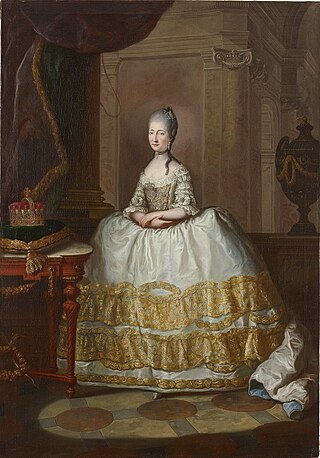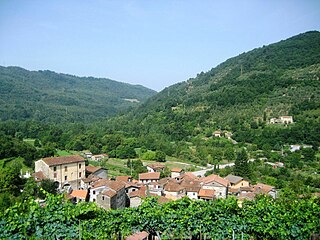
Carrara is a town and comune in Tuscany, in central Italy, of the province of Massa and Carrara, and notable for the white or blue-grey marble quarried there. It is on the Carrione River, some 100 kilometres (62 mi) west-northwest of Florence. Its motto is Latin: "Fortitudo mea in rota", a reference firstly to the marble shipping industry from Roman times onwards.

The Duchy of Modena and Reggio was an Italian state created in 1452 located in Northwestern Italy, in the present day region of Emilia-Romagna. It was ruled since its establishment by the noble House of Este, and from 1814 by the Austria-Este branch of the family. The Este dynasty was a great sponsor of the arts, making the Duchy a cultural reference during the Renaissance and Baroque periods.

Francis V, Duke of Modena, Reggio and Guastalla, Archduke of Austria-Este, Royal Prince of Hungary and Bohemia, Duke of Mirandola and of Massa, Prince of Carrara was a reigning prince. He was Duke of Modena, Reggio, and Mirandola, Duke of Guastalla from 1847 and Duke of Massa and Prince of Carrara from 1846 to 1859. His parents were Francis IV of Modena and Princess Maria Beatrice of Savoy. He was the last reigning duke of Modena before the duchy was incorporated into the Kingdom of Italy.
The Garfagnana is a historical and geographical region of central Italy, today part of the province of Lucca, in Tuscany. It is the upper valley or basin of the river Serchio, and thus lies between the main ridge of the Northern Apennines to the north-east and the Alpi Apuane to the west. The principal towns are Castelnuovo di Garfagnana and Barga.

The Lunigiana or Lunesana is a historical territory of Italy, which today falls within the provinces of Massa Carrara, Tuscany, and La Spezia, Liguria. Its borders derive from the ancient Roman settlement, later the medieval diocese of Luni, which no longer exists.

The province of Lucca is a province in the Tuscany region of Italy. Its capital is the city of Lucca.

The Duchy of Massa and Principality of Carrara was a small state that controlled the towns of Massa and Carrara from 1473 until 1836.

The House of Habsburg-Este, also known as the House of Austria-Este and holder of the title of Archduke of Austria-Este, is a cadet branch of the House of Habsburg-Lorraine and also descends from the House of Este in the cognatic line. It was created in 1771 with the marriage between Ferdinand of Habsburg-Lorraine and Maria Beatrice d'Este, only daughter of the Duke of Modena, Ercole III d'Este. After the death of Ercole III in 1803, the Modena ruling branch of the Este family's male line ended, and the Habsburg-Este line subsequently inherited his possessions in what is now Italy.

Massa is a town and comune in Tuscany, central Italy, the administrative centre of the province of Massa and Carrara. It is located in the Frigido River Valley, near the Alpi Apuane, 5 km (3 mi) from the Tyrrhenian Sea.

Fosdinovo is a comune (municipality) in the Province of Massa and Carrara in the Italian region Tuscany, located about 110 kilometres (68 mi) northwest of Florence and about 15 kilometres (9 mi) northwest of Massa.

Fosciandora is a comune (municipality) of 554 inhabitants in the Province of Lucca in the Italian region Tuscany, located about 70 kilometres (43 mi) northwest of Florence and about 30 kilometres (19 mi) north of Lucca.

Province of Pola was a province of the Kingdom of Italy created after World War I, that officially existed from 1923 until 1947. The capital was Pola. After the Second World War the province of Pola became part of Yugoslavia. Following the collapse of Yugoslavia in 1991, the province of Pola has been part of Croatia and Slovenia.

Maria Beatrice d'Este was the last descendant of the House of Este, of the House of Cybo-Malaspina and, through her maternal grandmother Ricciarda, also of the House of Gonzaga of Novellara and Bagnolo. Ducal princess of Modena and Reggio, she became the sovereign duchess of Massa and Carrara from 1790 until 1796 and from 1815 until her death in 1829. Through her marriage, she was co-founder of the new House of Austria-Este.

The Diocese of Massa Carrara-Pontremoli is a Latin diocese of the Catholic Church situated in north-western Tuscany, in the valley of the Frigido River. The city of Massa is on the south side of the river, 5 km (3 mi) from the Tyrrhenian Sea. The city of Carrara is 6 km (4 mi) north of Massa, on the Carrione River. The diocese is a suffragan of the Archdiocese of Pisa.

Codiponte is a village in the municipality of Casola in Lunigiana, Tuscany, Italy. It is located in the Province of Massa and Carrara and is about 20 minutes drive from the comune of Aulla. The population is about 200.
The 1920 Garfagnana earthquake occurred on 7 September in Garfagnana and Lunigiana, both agricultural areas in the Italian Tuscany region. The quake hypocenter was located 14 kilometres (8.7 mi) beneath Villa Collemandina. The maximum felt intensity was rated as X (Extreme) on the Mercalli intensity scale, and 6.6 on the Richter scale. It was one of the most destructive seismic events recorded in the Apenninic region in the twentieth century. Due to good news coverage, availability of official documents on the damage and abundance of recordings from surveillance stations throughout Europe, it was regarded as a first-rate case study to improve knowledge of tectonics and macroseismic analysis.

The House of Malaspina was a noble Italian family of Longobard origin that descended from Boniface I, through the Obertenghi line, that ruled Lunigiana from the 13th to the 14th centuries, and the marquisate of Massa and lordship of Carrara since the 14th century.

Via Vandelli is a historical commercial and military road, designed and built in the 18th century by Domenico Vandelli under the reign of Francesco III d'Este between 1739 and 1752. The road connected the city of Modena with the city of Massa, in its original project of 1739. In the 1750s, a variant was added, connecting Sassuolo, a residence of the Duke of Ferrara and of Modena, with the existing road from Modena to Massa. After Roman roads, Via Vandelli was the first road in Europe to be designed and realized according to a project fulfilling the customer requirements and modern engineering criteria. It is also the first road to be provided with taverns, inns and staging posts.

Apuania was a short-lived comune of the Kingdom of Italy, created in 1938 under the Fascist regime by merging the Tuscan cities of Massa and Carrara and the smaller town of Montignoso. The province of Massa-Carrara was accordingly renamed province of Apuania. Among the main supporters of this unified municipality were Fascist leaders Renato Ricci, from Carrara, and Osvaldo Sebastiani, from Massa. Apuania had an area of 181 square kilometres and population of 106,378 inhabitants, making up for over half of its province's overall population of 204,377; its motto was Ex tribus una. The administrative seat was located in Carrara, the largest of the three merged towns. The municipality of Apuania was dissolved in 1946, after which Massa, Carrara and Montignoso were re-established as separate municipalities.






















